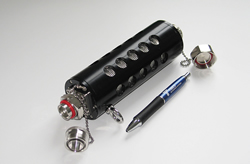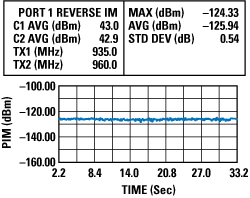
Competition in the cellular industry continues to drive the need to not only attract but keep subscribers. However, subscribers increasingly view cell service as a commodity driven in part by laws requiring cell phone numbers to be portable. Providers attempt to differentiate themselves with new services, but poor call reception remains a major reason subscribers change providers so the race to eliminate dropped calls remains a very high priority.
Passive Intermodulation Distortion (PIM) has been identified as a leading source of dropped calls in cell systems; therefore, it is understandable that providers view eliminating PIM sources as a high priority. PIM concerns have been raised for years, but are a relatively recent cell test criteria and still not completely understood by test technicians. Passive Intermodulation Distortion is caused by the presence of multiple transmit signals in a single transmission line or other components. The RF signals interact with each other at nonlinear junctions and create unwanted signals at frequencies that are the sum or difference of the transmit frequencies. If these signals fall in the receive band and are at high enough levels they can interfere with call quality and cause dropped calls. The levels that can cause problems in the receive band are more than 130 dB below the level of the carrier signal meaning that they can be generated by very small nonlinearities created by loose connections, the presence of non-ferrous metals or other reasons. They are difficult to measure and difficult to find and fix.
Independent contractors report finding the source of PIM frustratingly elusive and time consuming. Identifying the root cause is many times trial and error with a body of knowledge being generated from individual experiences. However, predicting the source in unique situations remains a challenge. For example, multiple systems now compete for space on the same or nearby towers and high PIM levels may only show up sporadically. The nearby landscape may have changed. Metal grates or large pieces of metal-encased equipment may have been added to a rooftop generating unacceptable PIM levels where none existed when the system was deployed. Tower vibrations can loosen any number of hundreds of connections. Individual components that exhibited acceptable PIM levels when first installed sometimes degrade with time, from antennas at the top to lightning protection devices down to internal radio components and jumpers. Even temperature changes may contribute to poor PIM performance.
Accepted practices to reduce PIM levels include using only non-ferrous metals and eliminating nickel under-plating in components used particularly in the transmit paths. Plating finishes must be smooth and are limited to silver or preferably non-tarnishing tri-metal (tin, copper, zinc). Reducing the number of pressure contacts between two pieces of metal within the primary RF path is desirable. When metal-to-metal contact is required (usually in a mated pair of connectors), clean, uniform, undamaged interfaces and high contact pressure is crucial. Specific torque values must be maintained. For 7-16 connectors, 21 ft-lbs is required. This brings us to the issue of how to get from the PIM tester to the DUT without introducing additional sources of PIM generated from the test lead itself.
Corrugated cable is typically used to achieve low PIM in the test lead. This eliminates the countless contact points found in the braided outer conductor of flexible coax, but the trade off is the lead can be difficult to handle and tends to kink mid-span or break more easily at the connector attachment area. Flexible coax makers historically have not focused on making low PIM, long flex life cable regardless of the application because of the high barrier to entry in this market.

Figure 1 Typical PIM performance.
By paying strict attention to the braiding process and materials, Times Microwave has developed several cable designs that exhibit reasonable flexibility, flex life and PIM performance (see Figure 1). PIM performance is better than -160 dBc at full PIM test equipment RF power levels. A three meter assembly exhibits approximately 1.25 dB of attenuation at 1 GHz. Drawing on its extensive experience supplying SilverLine-TGÔ (TuffGrip) phase stable test cables for cell site DTF measurements, Times outfits SilverLine-LP™ (Low PIM) products with a large armor and strain relief system that is another industry first. The armor withstands 1500 lbs per inch crush resistance. Connector retention exceeds 500 lbs. All pressure contact areas are eliminated in the assembly design in favor of full induction soldering for both center and outer conductors—not a trivial process when the entire product is heavily armored. As an added value, Times offers a set of three low PIM adaptors in a heavy duty protective nylon case and a limited-time test lead refurbishment program with every purchase of SilverLine-LP (part number SLS03-76M76M-02.75MK).
SilverLine-LP flexible low PIM test leads are also suitable for high volume production test. Beta site tests of SilverLine-LP with a maker of cellular antennas show SilverLine-LP lasts for up to six months in regular production use. As with any high performance test lead it is recommended to flex the product as little as possible for the longest life.
PIM testing also requires a PIM load suitable for the application. For tower testing, the most popular load on the market today is designed primarily for weight savings. If left under full power, it burns out quickly. Other designs that can handle full power are extremely heavy and cumbersome. Times portable PIM loads strike the ideal balance between weight (approximately three lbs) and full power handling. Times part number 67019 can handle full test equipment output power continuously for as long as is needed to troubleshoot a system. It comes equipped with both male and female 7-16 connectors eliminating the need for adaptors under certain test conditions or jumper configurations. Metal protective connector caps secured with metal chains, a frame-mounted lanyard loop, heavy-duty protective nylon case and wide wrench flats to assure proper torque are standard features not found in competing products.
For production or lab environments, Times also offers part number 67020 bench PIM load. The company’s bench model includes similar features to the portable model with the addition of an easy-to-use folding handle. For those more comfortable with traditional corrugated test leads, Times offers part number SLCOR03-76M76M-03.00M, 3/8" super flex corrugated cable test leads.
Times Microwave Systems
Wallingford, CT
(800) 867-2629
www.timesmicrowave.com
